The online access of a school district and its students is, today, more important than ever because you can’t sustain digital learning without it. The e-rate program alone, from the federal level, offers funded levels of support from twenty-percent to ninety-percent of cost, depending on levels of poverty, for internet access and related services.
Yet networks are largely still considered by teachers and students in many schools to be “unreliable.” Schools have made moves in the last several years to shore-up tech support systems and upgrade Wi-Fi delivery in classrooms, on campuses and all the way out to homes and the community. There have been partnerships within government and outside with private company grants, donations and funds.
What we’ve found in Alabama’s largest school district, serving 56,000 students in eighty-nine schools, is a story of real sustainability and “togetherness” to accomplish digital transition. David Akridge, the Chief Information Officer for the past ten years, shared their story of teamwork, in cooperation with peers in Curriculum, to accomplish digital transition.
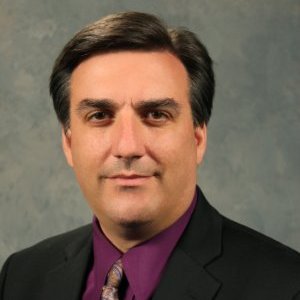 David Akridge: My focus from the beginning as the CIO was to get the infrastructure built. The first four or five years on the post we worked with e-rate to get the funding. The provider we worked with throughout has been Cisco, they have been great. I want to say as well, right from the outset, that it’s a "we" – we are a team. There is a Network Manager, a Telecommunications Manager, a Research and Development Manager and a Data Specialist. These guys make up my managers here, and also Michelle Collier who is the Coordinator of Instructional Technology.
David Akridge: My focus from the beginning as the CIO was to get the infrastructure built. The first four or five years on the post we worked with e-rate to get the funding. The provider we worked with throughout has been Cisco, they have been great. I want to say as well, right from the outset, that it’s a "we" – we are a team. There is a Network Manager, a Telecommunications Manager, a Research and Development Manager and a Data Specialist. These guys make up my managers here, and also Michelle Collier who is the Coordinator of Instructional Technology.
We meet together, we decide together, we roadmap together. Back in ’07 we built a strategic plan that we actually mapped on a board—it was a huge map in my office—a plan of how we were going to get to a sustained network that could provide what we felt was coming in the future.
We literally took five years on the first massive step—the infrastructure. We applied for the max amount of E-rate money that we could afford to apply for and, today, we have a 200-million-dollar network in the district that spans 1,600 square miles. We have nearly 5,000 access-points. We have wireless access-points in every classroom, one in every office and even outside access.
That was the key-focus for those first years of what we did here because our analogy was, that going all-in with tech and digital curriculum for teaching and le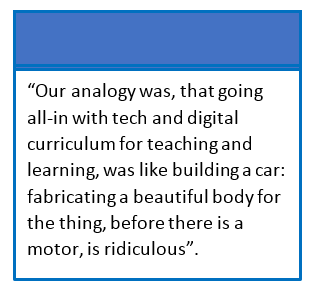 arning, was like building a car: fabricating a beautiful body for the thing, before there is a motor, is ridiculous. We had to get the motor and the drive-train and everything first and, once that’s done, then we can make anything we want to make after that. But the foundation had to be there.
arning, was like building a car: fabricating a beautiful body for the thing, before there is a motor, is ridiculous. We had to get the motor and the drive-train and everything first and, once that’s done, then we can make anything we want to make after that. But the foundation had to be there.
Learning Counsel: You’re a BYOD (Bring Your Own Device) district currently, with a large number of available devices for those kids who don’t have the resources. But do you have any pilot 1-to-1 programs where the school provides a take-home device to every child?
DA: We are very excited about that very thing. You need to understand, we’re in a socio-economically challenged area. There are a lot of kids that we need to support in our district and, unfortunately that means a lot of them don’t have internet access at home.
Our partners here such as Comcast and Mediacom, the cable companies, have done a lot to help provide low income families with internet access at home for as little as $10 a month and a lot of our families have taken advantage of that, we’re very proud of that. But, sadly, some people still just can’t afford $10 a month. It’s a situation where so many of them are very poor. We’ve been looking for ways to get technology in their hands because statistics show that homes that have internet access do better, the kids do better in school, there’s just tons of data to support that.
So, T-Mobile came to me and asked if I would assist on an implementation with the Mobile Alabama Housing Authority here. There were two smaller housing divisions here in Mobile with two or three hundred families living in each of those projects. So, a seven or eight-inch device, is being provided for no cost from T-Mobile.
LC: T-Mobile gives the device for free to those families and the County is going to pay for the access?
DA: Right. And, of course, T-Mobile has greatly reduced the price of the internet access to make it affordable. Then, we (Mobile County Public Schools) partnered with the Housing Authority and T-Mobile on this because so many of those families had students that were in our schools. We went with them and worked with T-Mobile to put the Apps and the Links to all our software that goes along with what we’re doing in the school district. Then we helped the families learn how to use the devices and how to access the reading apps and other digital curriculum. Michele Collier’s team did this work down at Mobile Central Library where the families picked up the devices.
T-Mobile’s National Education Grant
LC: How does this relate back to the school 1-to-1 pilot?
DA: The T-Mobile rep involved saw how we (at the school district) were involved with this housing project activity and why, and he told me about a multi-million dollar grant that T-Mobile announced—actually at your Learning Counsel National Gathering last November—for our type of situation and he told me I should submit.
So, we jumped at the opportunity to get that support. We heard back within days from T-Mobile that we’d been approved. I think we were the first school district in the U.S. approved for it. The grant supported a full 1-to-1 pilot for two elementary schools:
- Grant Elementary School in Prichard, AL
- Calcedeaver Elementary School in Mt Vernon, AL
One is an inner-city school and one is a very rural school, each having about 275 kids. We’re going to begin this program, most probably at the start of the new school year in August. The device we’re giving these kids will have the technology in it to be able to pick-up a Wi-Fi signal wherever they are, while being filtered back through the school system, even around one of the pilot schools which is in a rural area 40 miles north of Mobile. This would be the first time ever that many of these families have ever had Wi-Fi in their homes.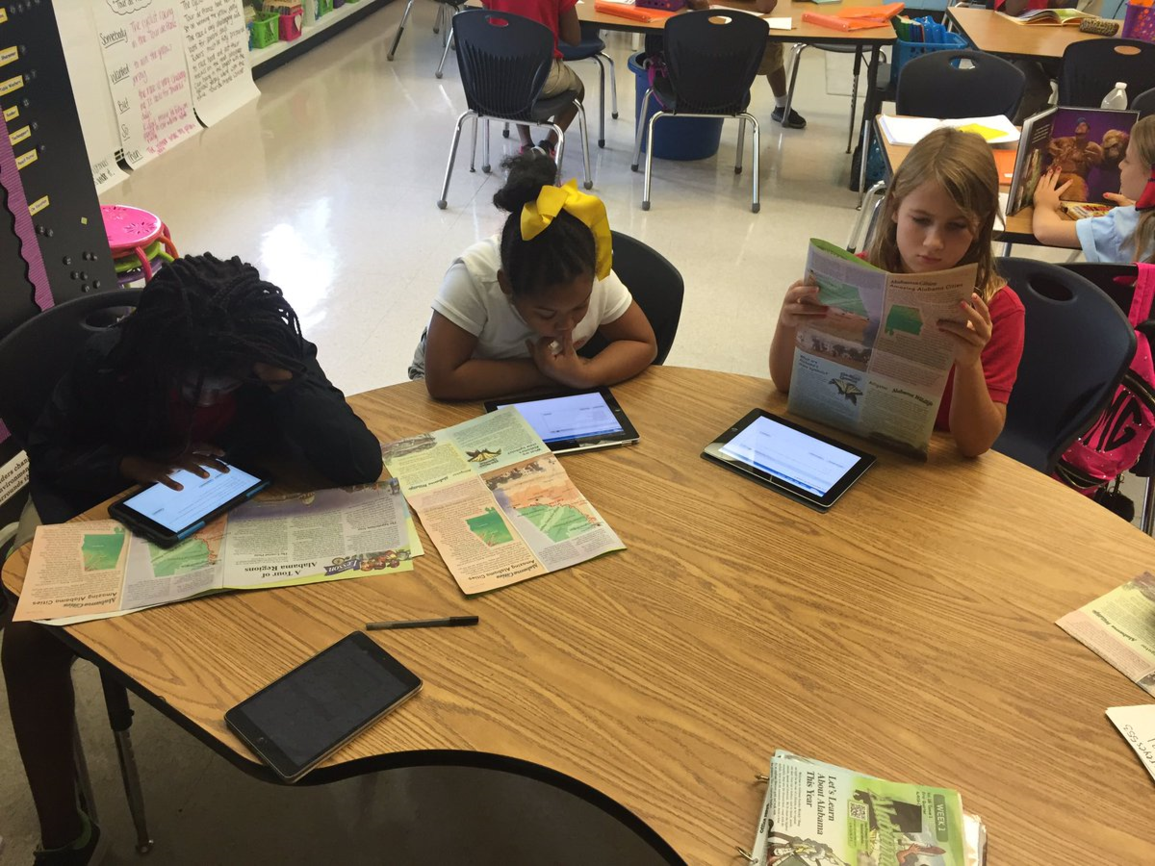
It’s a small enough, controlled area where I can watch it, look at it, get feedback and it’s also not very expensive. I am going to have to pay some of the internet access, but it’s not very expensive at all, especially for 550 kids. I’m going to get a lot of data from this and a lot of feedback and I really would like to see an expansion of this in a format where the district could afford to do this with T-Mobile across the entire region, because I really see a lot of potential for this, especially for low income families.
In our county schools, our outlying county schools, we’ve been very successful with BYOD. In our inner-city schools, whether it be that parents don’t want their kids to have devices on the streets, they don’t want them carrying them to school on the street for fear they’ll be stolen or, whatever the reason, we want to try to find an alternate method and I think that this T-Mobile project could be something that would work to accomplish that.
LC: Can you take us now to the next step and how your team’s network preparation established the structure to make digital teaching and learning possible?
DA: Yes. First off, you must realize that myself and the rest of the team are not curriculum people for the most part. I know you talked to Michelle, she used to be a school teacher. Aside from her, we are technology personnel. I have a degree in Computer Science. And so, during that time when we were completing our infrastructure, we began preparing ourselves for having a working knowledge of what we were going to do to make the shift to digital curriculum and devices. We did a lot of interviews with principals, we spent a lot of time in their schools, we did things in the classroom; listening to their ideas and the things that they thought.
At this time, it was several years back now, we also did an implementation of smartboards. We found the funding—pooled resources from anywhere we could, local budgets, state, district—and we got 4,000 electronic whiteboards for the classrooms which was a big deal back a few years ago.
What was good about that process was how it got everybody moving in the same direction. Everybody was on board with a strategic plan that said, “Here’s what we’re buying, here’s what we want in each classroom to start transforming, here’s what we want you to have for your teachers.” Every dime of money that came in during that time was tracked so we could get those whiteboards.
The next big push was to move from system-based software to all our software being cloud-based.
Today we have the network and infrastructure. Now we’re trying to be inventive and stepping ahead with anything that we can do to support and empower our students and teachers.
LC: What steps are you taking now with professional development to support your teachers and school level administrators?
DA: That’s really under the purview of Michelle Collier from my team. She is the bridge.
LC: What do you mean “the bridge?”
DA: She is the bridge between tech and academics. She reports to both me and to the Chief Academic Officer. She’s been in this position for many years, but two years ago we shifted the pattern of operation. There was no choice but to make the shift to adjust for the way we’re teaching today. Tech 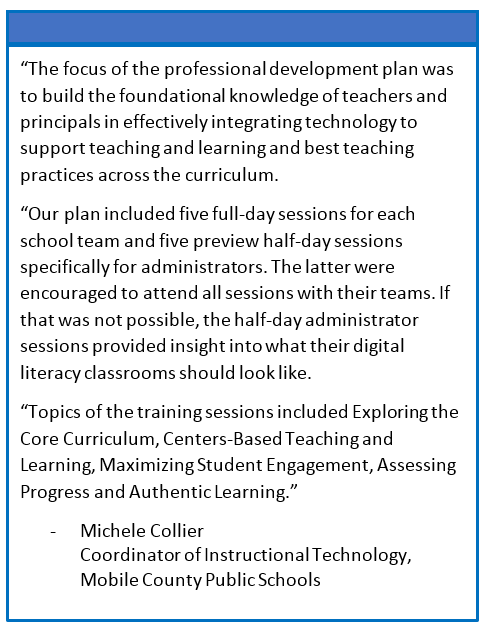 has entered the classroom. She runs our instructional technology specialist team who support the teachers. They work within the schools to help teachers use the tech and all the digital curriculum.
has entered the classroom. She runs our instructional technology specialist team who support the teachers. They work within the schools to help teachers use the tech and all the digital curriculum.
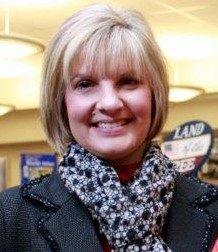 She oversees a partnership program with Discovery Education which so far involves 50 schools, and we plan to take it to all schools in the district. The program includes training a five-person team from every school. This team is: The Principal, a new position we call the Digital Literacy Media Specialist and three core curriculum teachers. It’s a three-year program that is now at the end of its second year of implementation, and we recently had our first five-person team “graduate.”
She oversees a partnership program with Discovery Education which so far involves 50 schools, and we plan to take it to all schools in the district. The program includes training a five-person team from every school. This team is: The Principal, a new position we call the Digital Literacy Media Specialist and three core curriculum teachers. It’s a three-year program that is now at the end of its second year of implementation, and we recently had our first five-person team “graduate.”
What we’re accomplishing is core teachers who know how to use all the different tools that are in the classroom. This is incredibly important. They can then help all the other teachers as they expand their use of technology. It would be virtually impossible to train all 3,100 of our teachers in this same way. There are a lot of “train-the-trainer” type methods where we try to keep the people that are in that group trained on the latest things that we’re doing so that they can filter that back out to the schools and work on using document cameras, using the tablets, the latest software and digital curriculum.
LC: Can you share with us some of the main digital curriculum the teachers are using, what’s popular?
DA: We’re using Big Universe which is a great software, one that we’re enjoying very much, has 10 or 15,000 volumes of books that are online for students to read and they are aligned to our state standards and the Renaissance Star 360 program that we use to test. With Big Universe, the kids can pick out books during the summer. If they have summer reading they don’t have to go the library, the books are aligned with their grade level and what they have to do to be tested on. That’s a huge program that we’re very proud to have.
I know they’re using Learning.com. Discovery as I’ve mentioned is a huge program in the district.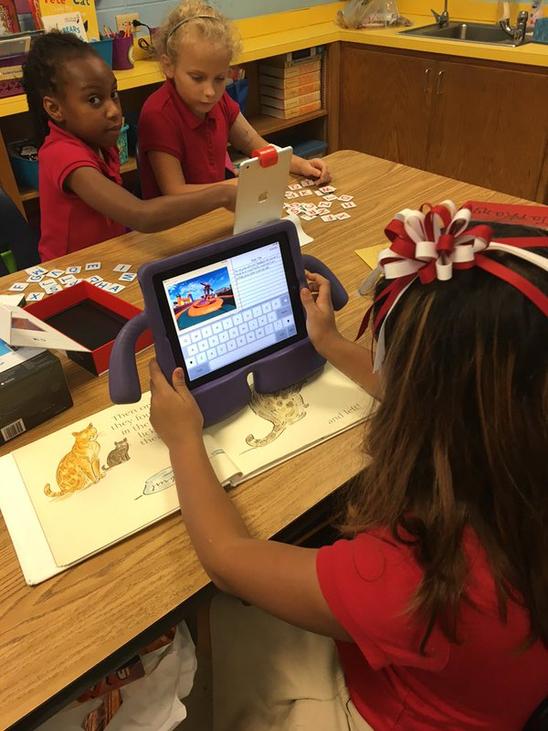
Most of the software we’re using is very video intensive. This goes back to being proud that we have a network that can sustain that. If we did not have the infrastructure that we have, it would just not be feasible to do what we’re trying to do. I should also mention testing in this regard. We’re the largest district in the state, by far, but also the only one that, I believe, has the sustainable infrastructure to do testing for 35,000 kids and we’ve done that for 3 years now, fully digital—no more pencils.
LC: What’s your operating platform? In other words, what platform are you using for your administration, teachers and students to access school work, assignments, etc?
DA: We are a Microsoft District. Every student and every employee has a login and we have unlimited cloud storage. A student can log any device into our network to gain internet access no matter what school they’re at. If they need to get something on the network, they can drive up to any campus and do that.
Once a year we purchase a system-wide license that grants us permission to use all their software. It’s an EES license. (Enrollment for Education Solutions). It’s a blanket payment every year that gives us the right to license their software throughout the district. Microsoft is growing in the education market. In the last three years Microsoft has stepped up and they are really on the forefront now helping education. The value we get for what we pay is enormous.
Microsoft actually called together meetings with CIO’s across the country (myself included) to ask us what was needed and wanted and they listened. It’s an American company, they should be caring about education and they’ve done that and I’m very proud for them. That’s one reason why we’re very loyal to them, and they’ve got a good product.
LC: Any final notes or comments you’d like to share?
DA: We feel like it’s our job to give these companies feedback and data so that they can alter, change, work around policies, or do something to fit. If they can’t put something out and test it and get feedback then they’re not ever going to be able to make the changes that are necessary to make something successful in education, or anywhere. We’re proud of our company partners for how they work with us.











